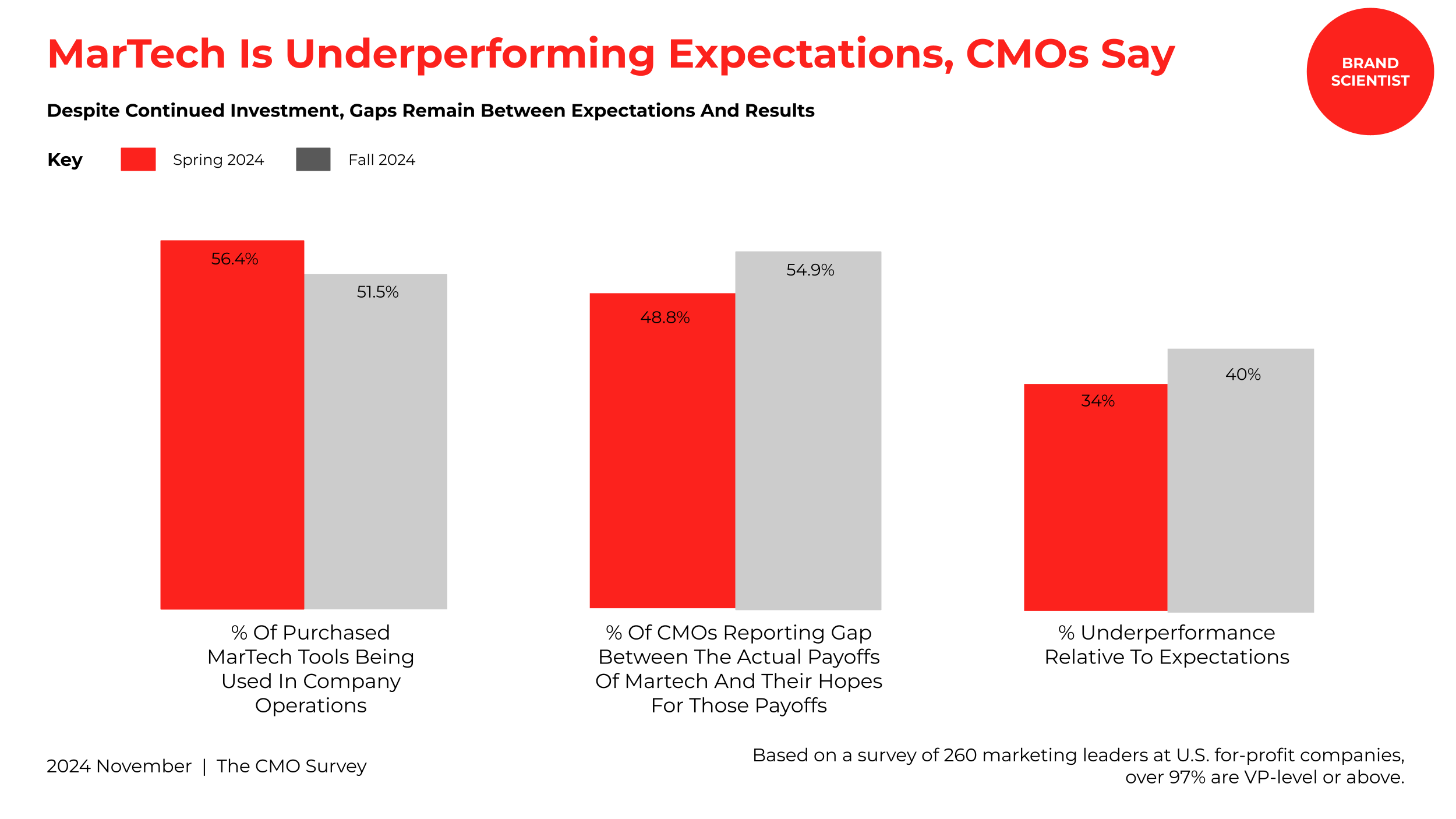Gaps Remain Between Expectations And Results Despite MarTech Investments
Despite continued investment in marketing technology (MarTech), many companies find that these tools are not delivering the expected impact, according to the Fall 2024 edition of the CMO Survey. A majority (55%) of US CMOs report a gap between MarTech’s actual and expected payoffs, marking a decline from the Spring 2024 survey, where 49% expressed similar concerns. The reported gap between actual and expected performance has widened to 40%, compared to 34% in the previous survey, highlighting increasing dissatisfaction with MarTech effectiveness.
MarTech tools are making only a modest impact on company performance, with CMOs rating their effectiveness at an average of 4.8 out of 7—only slightly above the neutral score of 4.5. While this represents a minor improvement from the Spring survey (4.7), it suggests that MarTech is not delivering strong, measurable business value. This skepticism is not new; last year, 76% of senior US marketers expressed doubts about achieving the desired ROI from MarTech investments.
A significant problem contributing to MarTech underperformance is underutilization. Currently, only 51.5% of purchased MarTech tools are being actively used in company operations, down from 56.4% in the Spring. This continues a troubling trend, as MarTech utilization rates have steadily declined over the past few years, from 58% in 2020 to just 33% last year. Despite this, companies plan to increase spending on MarTech, with CMOs expecting to allocate 22.8% of their budgets to these tools next year and up to 31.7% within five years.
B2B companies, in particular, anticipate heavier investments in MarTech. B2B Product companies project allocating 34.1% of their budgets to MarTech in five years, while B2B Services companies foresee an even larger commitment of 35.3%. However, both groups report lower satisfaction with MarTech’s impact, with B2B Services companies rating its effectiveness at just 4.5 out of 7 and B2B Product companies slightly higher at 4.8. As investments rise, these companies will be expecting significant improvements in MarTech performance and ROI.
Key Actionable Takeaways:
Evaluate MarTech ROI Regularly – Continuously measure MarTech’s performance against business goals to determine whether tools are delivering expected value.
Improve MarTech Utilization – Assess current tools and streamline usage to ensure that purchased MarTech solutions are fully integrated into marketing operations.
Invest in MarTech Training – Provide ongoing training to marketing teams to increase adoption rates and improve the effective use of existing tools.
Prioritize Integration and Interoperability – Ensure MarTech solutions integrate seamlessly with existing systems to maximize efficiency and minimize workflow disruptions.
Focus on Data-Driven Decision-Making – Use analytics to track MarTech effectiveness and optimize strategies based on performance insights.
Avoid Shiny Object Syndrome – Be strategic about new MarTech investments by focusing on solutions that directly align with marketing objectives rather than chasing trends.
Conduct Regular Martech Audits – Periodically review the MarTech stack to eliminate redundant or underperforming tools and improve resource allocation.
Increase Collaboration Between Marketing and IT – Work closely with IT teams to ensure that MarTech solutions are properly implemented, maintained, and optimized.
Enhance Customization and Personalization Capabilities – Invest in MarTech tools that support personalized customer experiences, as this is a key driver of marketing effectiveness.
Set Realistic Performance Expectations – Establish clear, measurable goals for MarTech performance to align expectations with achievable results and track progress over time.
